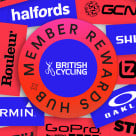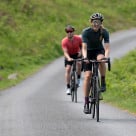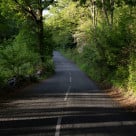Get Into Cycling - Mountain Biking - Clothes
Mountain Bike Clothing
Wearing the right mountain bike clothing and equipment can be the difference between loving and hating the ride - but don't let it limit what you do. There's nothing to say you can't go mountain biking in jeans, t-shirt and trainers - but if you start to take your mountain biking more seriously then a set of specific clothing will make riding year-round a lot more appealing.
The Essentials:
Helmet (Costs £20-£300)
As always, a helmet is desirable, but remember all are made to the same basic safety standard so choosing one is down to comfort, looks and breathability. Don't be afraid to try on several different brands of helmet to find one that suits the shape of your head, it will be time well spent. Not all helmets are created equal so understand the adjustments available and how they work so when you get home it's possible to fine tune the fit.
The average lifespan of a helmet which is not crashed on is three years - the only thing you'll have to replace are the Velcro pads inside. If you do crash the advice is always to replace your helmet, even if there is little visible damage. It needn't be an expensive experience either because most manufacturers operate a crash replacement system; you send the damaged helmet back to the manufacturer who for a nominal price will send you a new one.
If you're riding downhill then for most tracks a full face helmet is compulsory, along with pads and possibly body armour.
Shoes and Pedals (Costs £30-£350)
The first cycling specific choice you'll have to make is whether to use flat or clipless pedals and shoes. Flat pedals are simply pedals with a platform; with which you can use any shoe, whereas clipless pedals use a system similar to a ski bindings. Using a specialist metal cleat which is screwed into the bottom of the shoe and a pedal to which the cleat ‘clips in', this design makes for a secure connection and greater pedalling efficiency.
There are several clipless pedal and cleat designs, all essentially doing the same job of keeping the foot in constant contact with the pedal. All shoes work with all cleats and pedals - with the most expensive using carbon fibre soles for the lightest weight and best power transfer through the pedal stroke.
Beyond The Basic - Wearing Lycra For The First Time
Chamois Up!
You may not want to look like a superhero in spandex, but you can be assured that the alternative of getting your John Wayne on for Monday morning in the office is no great look. This means if you're riding cross country then pay attention to saddle choice in conjunction with short choice. A good set of lycra shorts (even when incorporated as a liner within a baggy short) are defined by how well they fit you, as nearly all manufacturers have conquered chamois design.
Created to stretch and form with your body any wrinkles in the material are a sign you've gone a size too far. For comfort bib shorts are a great choice because they actually hold the chamois in place.
In winter it is desirable to wear shorts with knee warmers or leg warmers. In extreme conditions a pair of non padded bib tights should be worn over the top of bib shorts. Padded bib tights are undesirable as they often pull down, creating additional friction between the chamois and the skin.
The final touch is to add chamois crème to the pad - creating a barrier to bacteria and lessening the chance of saddle sores developing.
Creating A Wardrobe
As all cycling kit works together as a layering system, getting the best out of specialist clothing by creating a wardrobe is a great way to ensure you are comfortable in all conditions. The best time to start building is in the summer, that way you start with the basics and can spread the cost.
Layer One:
Socks/Shorts/Chamois Crème/Baselayer/Shortsleeve Jersey/Gilet
The first layer is the most important in terms of comfort because it is the only point of direct contact with the skin. Generally any socks are fine for summer usage, a simple baselayer, shortsleeve jersey and gilet will cover all conditions from thirteen to thirty degrees.
The most important aspect of the kit is a pair of quality shorts and chamois crème. This pairing will be used throughout the year so it pays to invest in something that will last summer and winter.
Layer Two:
Oversocks/Legwarmers/Longsleeve Jersey/Waterproof Jacket/Waterproof Shorts
Layer two serves to create a barrier in mild, wet conditions, while being warm enough for cooler climes. These two combinations are the most common in the UK, along with the age-old problem of overheating in a waterproof jacket. The myth of wet conditions always being cold is addressed in this setup and should prevent boil in a bag syndrome - especially in a high activity sport like mountain biking.
Layer Three:
Winter socks/Overshoes/Unpadded Tights/Windproof soft shell/Hat/Winter Gloves
The final kit is designed for deep winter and for most will be unnecessary. Utilising all other kit will usually suffice but when temperatures move toward sub zero and dry this combination will make light of the conditions.




